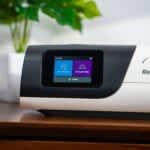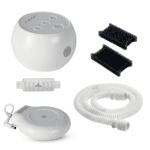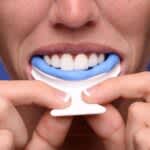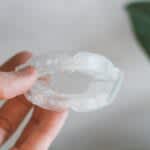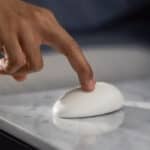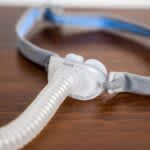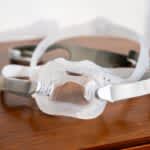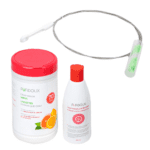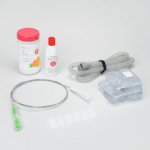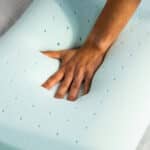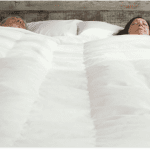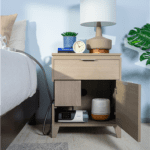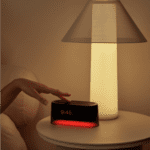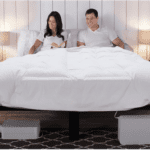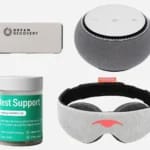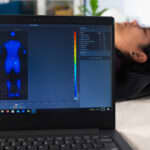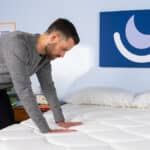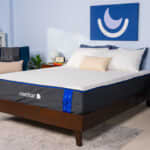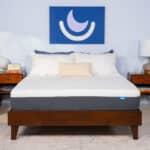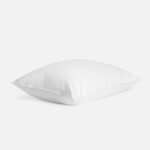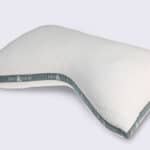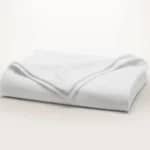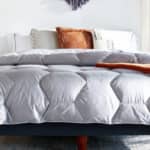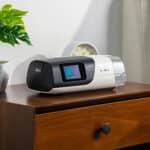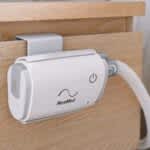It can be tough to get a real sense of what you’re getting when you shop for mattresses and sleep accessories online when the sheer amount of information available today makes it nearly impossible to understand how a product will perform in real life.
We know that beds and sleep products are big purchases that have a direct impact on your health and quality of life. We also understand that you should be able to make an informed purchase — which is why our team personally tries every product that appears on our website.
Since comfort is ever-changing and different from person to person, it’s critical to get a comprehensive idea of how a product performs for a variety of people. To help us understand which sleepers will get the most from a particular product, we solicit real-world customer feedback and combine it with objective tests like heat mapping and motion sensing and subjective trials that measure comfort and support.
Meet Our Product Testing Team
Dr. Michael J. Breus is our namesake and top sleep expert. He’s been in private practice as a sleep doctor for nearly 25 years and is a Diplomate of the American Board of Sleep Medicine and a Fellow of the American Academy of Sleep Medicine. Throughout his years in practice, Dr. Breus has seen first-hand how sleep products can affect long-term health — both positively and negatively.

Working alongside Dr. Breus is our team of sleep product experts who’ve spent almost a decade testing and evaluating sleep products in their homes and our Seattle Test Lab. Our testers have varying body weights, sleep preferences, and needs, which helps us get an inclusive picture of how a sleep product will perform for our readers. You can learn more about our team of experts here.
Integrated Product Research
We’re sleep experts, but we’re people, too — and we know the challenges that can accompany sleep. We’re parents, partners, insomniacs, light sleepers, sleep-like-the-dead sleepers, CPAP users, tooth grinders, hot sleepers, cold sleepers, and cost-conscious shoppers.
We created our research methodology by combining our expert knowledge with our real-life experiences. We know what works for hot sleepers because the hot sleepers on our team tell us. We use our testers’ experiences along with the hard data from our objective trials to review and recommend products. We also take customer reviews into account because product performance can change over time, which real-world feedback shows.
Before recommending anything to our readers, it’s critical for us to get a well-rounded and holistic view of how a product really works, and for whom it works best for.
How We Test Mattresses
Comfort and support are the most important factors to the majority of sleepers, so they’re the most important to us too. What they mean can vary though — what a 100-pound 12-year-old finds comfortable is likely pretty different from a 220-pound sleeper with back pain.
There’s no one-size-fits-all comfort solution, which is why we break our reviews down into multiple categories. By investigating every mattress against the same factors, you can see exactly how a bed performs in the categories that are most important to your own comfort and support.
Consistency Is Key
We use standardized procedures to limit bias and make sure we test every mattress the same way. It’s important to reduce as many variables as we can to make sure our results are accurate.
Here’s how we do it:
- We use the same testers who perform the same, predetermined movements or motions.
- We divide time evenly to make sure each bed gets the same testing time.
- We use the same testing methods and devices for every mattress.
- We take baseline measurements before diving in.
We look at the following performance and construction categories when we test mattresses in the lab and at home.
Firmness
Mattress manufacturers typically assign their beds a firmness, but we’ve found that companies’ firmness ratings aren’t always comparable across the board. So, we use our own 10-point scale to measure mattress firmness. The softest mattresses rank as a 1 and the firmest as a 10. Most beds made today are between 3 (soft) and 8 (firm).
Softer mattresses conform and compress more than firmer mattresses do. Generally, the softer the mattress, the more it will contour around your body. Firm and extra firm models typically have very little cushioning or contouring, and it takes more pressure to compress their layers.
How manufacturers achieve these firmness levels can vary depending on materials and constructions, so a medium firm (6) all-foam mattress will feel and perform differently than a medium firm (6) latex mattress, even though they share the same firmness.
Here’s our 10-point scale:
1-2: Extra Soft
3: Soft
4: Medium Soft
5: Medium
6: Medium Firm
7-8: Firm
9-10: Extra Firm
The firmness level you like best is a personal preference, but your weight and sleeping position determine what you’ll find most comfortable.
Sleeping Positions
Most people sleep on their sides, backs, stomachs, or a combination of all three. Side sleepers usually like softer mattresses than back and stomach sleepers because their weight is concentrated on less surface area — under their hips and shoulders. If a mattress is too firm, they won’t be able to compress the mattress enough, and that creates pressure points beneath their side bodies.
Back sleepers are the Goldilocks of sleeping positions; they generally prefer a bed that’s not too soft and not too firm. The ideal model will push back under their lumbar (lower back) to keep their spines in alignment.
Stomach sleepers typically like firmer mattresses than side and back sleepers. When they sleep on a bed that’s too soft, their body can sink and create an uncomfortable “trapped in the bed” feeling that causes their spine to arch. A firmer mattress can counteract that feeling and keep stomach sleepers situated atop their mattresses.
When we test mattresses, team members with different sleeping positions try the same bed to see exactly how it feels in their preferred sleeping position.
Sleeper Weight
The more a person weighs, the more they compress their mattress. The opposite is true for lighter sleepers. If a person who weighs over 230 pounds sleeps on a soft mattress, they’ll likely sink into the mattress’ layers, which will create an uncomfortable bend in their spine. If a person under 130 pounds sleeps on a firm bed, they won’t be able to compress the layers enough to prevent sore spots.
Though there can be exceptions, people with similar weights generally have common experiences during mattress testing. Because of this, we use three categories when we discuss body weight.
- Less than 130 pounds: Lighter-weight sleepers don’t have the mass to easily compress a mattress’s many layers, so they typically prefer beds between soft (3) and medium (5). Mattresses in this range give them strong support and enough cushioning to prevent soreness.
- 130 to 230 pounds: Those in this category usually like medium (5) to medium firm (6) beds the best because they have a balance of cushioning and spinal support.
- More than 230 pounds: Heavier sleepers need structure and an even sleep surface to keep them from sinking into their mattress. Generally, the best bet is a bed that’s between medium firm (6) and firm (8).

Our ratings and suggestions are an excellent place to begin, but you know your body better than we do. Take advantage of sleep trials to test out a mattress yourself and give it at least a couple months to get a real sense of how it supports your weight.
Movement Isolation
If you wake up easily when a partner moves, a mattress that isolates motion effectively can help. When you move on a responsive bed, that motion ripples out like a shockwave or water droplet. It travels to the other side of the bed, which can make staying asleep tough if you share a bed with children, a partner, or pets.
We evaluate motion isolation using three methods. First, we do a body test where two testers lie next to each other, then one tester performs natural movements like rolling over and tossing and turning while the non-active tester measures how much disturbance they feel. We do the same test swapping the active tester for a 15-pound kettlebell. We drop the kettlebell from standardized heights while the non-active tester takes measurements.
We also perform these same tests while using SensorTag technology, which measures movement similarly to a seismograph. Our final test is a liquid test, which you’ve probably seen in mattress commercials. Our tester performs the same natural movements with a container of water on the other side of the bed. The tilt of the water, ripples, and position of the glass give us good indications of a bed’s motion isolation.
Edge Support
Edge support is important for a few reasons. If you like sleeping at the side of your bed but find that you always roll towards the middle, a stronger perimeter can help. A structured edge can also make it much easier for people with limited mobility to get in and out of bed.
To test edge support, we sit directly on the mattress’ edge to see how much it compresses over time. Our testers repeat this on different parts of the mattress so we can see if there are weak spots. Then, we do an edge-laying test, where a tester starts in the middle, and then incrementally works their way towards the side to measure stability.
Finally, we get in and out of bed repeatedly to see how hard it is to get on and off the mattress. We measure compression and time how long it takes for the edge to return to its original shape.
Heat Retention
The ideal room temperature is between 65 and 68 degrees Fahrenheit. With the human body being a warm 98.6 degrees, it’s easy to heat up your mattress. A bed with strong airflow and temperature-regulating materials can help ensure that you stay cool while you sleep.
We measure heat retention by filling a hot water bottle with 98.6-degree water and then placing it on the mattress for 15 minutes. After removing the bottle, we measure the bed’s temperature to see if the heat dispersed. We also use a thermal camera and laser thermometer to determine heat retention.
After we take these measurements, our testers lie on the mattress to see how it feels. They examine airflow, body contouring, and heat build up, which all affect temperature regulation.
Durability
The average mattress lasts between 6 to 8 years, though construction methods and materials have a big impact on longevity. Durability is one of the toughest qualities to predict, so we rely on design, materials, and construction quality to determine how a mattress will hold up over time. We also look at customer reviews and survey feedback to help us understand a model’s durability.
Some heavy-duty, long-lasting features to look for are high-density foam, thick metal coils, organic latex, and perimeter reinforcement.
Pressure Relief
People with joint pain, side sleepers, and those with back pain often find a pressure-relieving mattress beneficial. Hips, shoulders, and the lumbar area are most vulnerable to pressure point discomfort because they carry most of the body’s weight. Memory foam, polyfoam, zoned support, and latex relieve pressure effectively by absorbing impact and dispersing your weight evenly so that it doesn’t pool in one part of the mattress.
To measure a mattress’ pressure relief, our testers lie in different positions for a set amount of time to see if they notice pressure points starting to develop. We also use mapping technology that shows us where pressure concentrates.

Odor Emissions
Unfortunately, the “new mattress smell” doesn’t inspire candles or air fresheners like the “new car smell.” After unwrapping and installing a new mattress, there’s often a chemical-like odor from volatile organic compounds (VOCs) that are released into the air during a process called off-gassing. This smell typically dissipates after 24 to 48 hours.
Despite the name, VOCs are generally considered harmless, though they can be uncomfortable for people sensitive to smell and those with breathing issues. Foam and latex typically have strong odors, as do mattresses shipped in a box. To measure how much a mattress off-gasses, we test the strength of its odor across 24 hours. We also use a VOC meter to take readings at three different time intervals.
We recommend that you air out new mattresses in a well-ventilated space. Use the manufacturer’s directions or give it at least 24 hours if there aren’t off-gassing guidelines. While VOCs shouldn’t affect your health, sleeping on a mattress that smells like chemicals or rubber isn’t an ideal way to get comfortable on your new bed.
Ease of Movement
Responsive mattresses with coils or latex tend to be easier to move around on than those with squishy, compressive materials like memory foam or polyfoam. Combination sleepers, people over 230 pounds, and stomach sleepers often prefer a responsive mattress because they’re more comfortable when they can shift positions without getting stuck.
However, not everyone likes a mattress that’s easy to move around on. If you prefer the feel of a body-hugging, adaptive bed, you may want to seek out a model with a lower ease of movement score. To determine how easy it is to move on a bed, we measure how deeply a mattress compresses under weight, and how long it takes to return to its original shape. We use kettlebells and body tests to take these measurements.
How We Test Other Sleep Products
We think your bedding deserves just as much attention as your mattress. The right combination of products can make your sleep environment more comfortable for a better night’s sleep and is an excellent way to stretch your budget without buying an entirely new mattress.
Here’s how we test some of the most popular sleep accessories.
Pillows
Is there any sleep product that sparks as much debate as the humble pillow? Everyone has an opinion on what makes the perfect pillow. The qualities that make a model ideal for a side sleeper who gets ear tenderness will be quite different from a stomach sleeper who uses a CPAP. Luckily, with the seemingly endless pillow designs and constructions available today, nearly everyone can find the best pillow for their needs.

We examine pillows for their:
- Support: The right pillow will cradle your head and neck, keeping them at a neutral angle—whether you’re on your back, side, or stomach—so you’re not craning forward or arching backward.
- Firmness: While ideal firmness depends on personal preference and sleeping position, we make sure the pillow “bounces back” when you get up and retains its shape over time.
- Shape: Pillows come in a variety of shapes: standard (rectangular), contour (curved), wedge (triangular), and cervical (orthopedic). We make sure that, regardless of shape, the pillow keeps your spine in alignment.
- Fill material: Just like shape, pillows can be filled with different materials: down, polyester fiberfill (polyfill), feather, memory foam, buckwheat, cotton, wool, latex, and microbead. Along with type, we also test to make sure there’s enough volume to adequately support sleepers.
- Moldability: You want a pillow that conforms to the curves of your head and neck, particularly if you tend to change sleeping positions.
- Breathability: Certain materials and construction methods allow for more airflow and moisture wicking than others, which can be especially important for hot or sweaty sleepers.
- Overall feel: Though this can be subjective, we make sure the pillow is soft and plush—no one wants to sleep on a lumpy, scratchy pillow.
We test each model while sleeping in all positions to see how they differ. Weight also plays a factor in a pillow’s support, so we use the same weight groups as we do when we test mattresses.
Weighted Blankets
To get the most comfortable weighted blanket, you’ll want to consider what aspects are most important to you, whether that’s the blanket’s actual weight or the feel of its fabric. We score weighted blankets using a few metrics including:
- Breathability
- Warmth
- Durability
- Ease of cleaning
- Weight options
We rely on the same combination of subjective comfort-based tests and objective trials that result in hard data. For example, we measure breathability and warmth with both thermal sensors and reports from our testers’ experiences.
Mattress Toppers
A mattress topper is an excellent tool if you want to change your bed’s feel or extend its life. A memory foam mattress topper can make any bed better at relieving pressure, while a latex topper can create a more responsive surface. Couples with different preferences can use separate toppers to get their own ideal sleep surface without impacting their partner’s comfort.

Our topper testing methods are similar to our mattress testing methods, in that testers from different weight groups and sleeping positions try each topper and score them with comfort and support in mind. We also use much of the same technology that we do for mattresses, including heat mapping, kettlebell drops, and compression measurements.
CPAP Machines
To test continuous positive airway pressure (CPAP) machines and their accessories (which require a sleep apnea diagnosis and a prescription to use), we lean on our team of Sleep Care Advocates and respiratory therapists who have decades of experience working directly with patients and machine manufacturers.

We leverage our considerable expertise in sleep apnea diagnosis and treatment, and combine it with customer feedback, peer-reviewed research, and emerging technology to help patients make the best therapy decisions for their individual needs.

